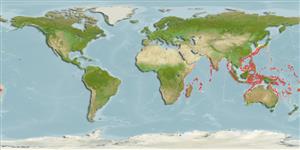Environment: milieu / climate zone / depth range / distribution range
Écologie
marin démersal; profondeur 150 - 278 m (Ref. 44037). Deep-water
Indo-West Pacific: including Japan.
Taille / Poids / Âge
Maturity: Lm ? range ? - ? cm
Max length : 11.4 cm SL mâle / non sexé; (Ref. 11148)
Épines dorsales (Total) : 0; Rayons mous dorsaux (Total) : 85 - 97; Épines anales: 0; Rayons mous anaux: 71 - 81; Vertèbres: 40 - 42. Pelvic fin on ocular side slightly elongate, extending to near the tip of the isthmus, the distance between the tip of the isthmus and the insertion of the pelvic fine subequal to the length of the pelvic fin base. Second ray of the pelvic fin on ocular side opposite to the 1st on the blind side. In male, the 12th to 18th dorsal rays and the 1st to 8th anal rays greatly elongated into filaments (Ref. 559). Soft ray count of pectoral fin refers to that on ocular side.
Life cycle and mating behavior
Maturité | Reproduction | Frai | Œufs | Fécondité | Larves
Masuda, H., K. Amaoka, C. Araga, T. Uyeno and T. Yoshino, 1984. The fishes of the Japanese Archipelago. Vol. 1. Tokai University Press, Tokyo, Japan. 437 p. (text). (Ref. 559)
Statut dans la liste rouge de l'IUCN (Ref. 130435: Version 2024-1)
Menace pour l'homme
Harmless
Utilisations par l'homme
Outils
Articles particuliers
Télécharger en XML
Sources Internet
Estimates based on models
Preferred temperature (Ref.
123201): 13.8 - 21.4, mean 16.9 °C (based on 86 cells).
Phylogenetic diversity index (Ref.
82804): PD
50 = 0.7500 [Uniqueness, from 0.5 = low to 2.0 = high].
Bayesian length-weight: a=0.00912 (0.00408 - 0.02036), b=3.04 (2.85 - 3.23), in cm total length, based on LWR estimates for this (Sub)family-body shape (Ref.
93245).
Niveau trophique (Ref.
69278): 3.5 ±0.4 se; based on size and trophs of closest relatives
Résilience (Ref.
120179): Milieu, temps minimum de doublement de population : 1,4 à 4,4 années (Preliminary K or Fecundity.).
Fishing Vulnerability (Ref.
59153): Low vulnerability (10 of 100).
